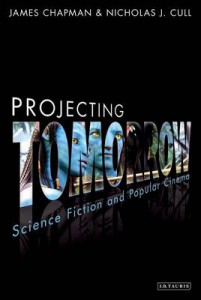Projecting Tomorrow: Science Fiction and Popular Cinema by James Chapman and Nicholas J. Cull, (I.B. Tauris, 2013), 240 pages, ISBN: 978-1-78076-410-8 (paperback), £14.99
 About the reviewer: Mark Bould is Reader in Film and Literature at the University of the West of England. He co-edits Science Fiction Film and Television, and his most recent books include Science Fiction: The Routledge Film Guidebook (2012) and, with China Miéville, Red Planets: Marxism and Science Fiction (2009).
About the reviewer: Mark Bould is Reader in Film and Literature at the University of the West of England. He co-edits Science Fiction Film and Television, and his most recent books include Science Fiction: The Routledge Film Guidebook (2012) and, with China Miéville, Red Planets: Marxism and Science Fiction (2009).
Although serious critical discussions of sf and cinema can be traced back at least as far as the first book of film theory, Vachel Lindsay’s The Art of the Moving Picture (1915), the genre was largely neglected during the development of Film Studies. This might seem surprising, given the discipline’s early tendency to privilege masculine-coded genres, such as westerns and crime movies, but it is not really: sf has often been seen as juvenile, more concerned with fantasy than realism, and with spectacle than narrative or character. Indeed, despite some forerunners, the serious academic study of sf film did not really get under weigh until the ‘postmodern turn’ suddenly made films such as Alien (1979), Blade Runner (1982), The Thing (1982), Videodrome (1983) and The Terminator (1984) seem relevant far beyond the genre’s regular audience.
 This conjuncture, however, had particular consequences for the shape the study of sf film took, not least in terms of forming a rather limited and unrepresentative canon and of emphasing critical-theoretical approaches. Projecting Tomorrow focuses solely on American and British film, but within that limitation strikes an effective balance between canonical and less-well-known examples, devoting twelve chapters to, respectively, Just Imagine (1930), Things to Come (1936), The War of the Worlds (1953), the Quatermass trilogy (1955, 1957, 1967), Forbidden Planet (1956), 2001: A Space Odyssey (1968), Planet of the Apes (1968), The Hellstrom Chronicle (1971), Logan’s Run (1976), Star Wars (1977), RoboCop (1987) and Avatar (2009). However, in privileging ‘the evidence of the archives’, Chapman and Cull rather over-egg the pudding, several times dismissing well-theorised approaches to sf film as ‘voguish trends in cultural studies’ – as if historiography were somehow neutral, objective and unchanging, as if primary materials did not require interpretation, as if effective interpretation did not require theoretical self-reflection.
This conjuncture, however, had particular consequences for the shape the study of sf film took, not least in terms of forming a rather limited and unrepresentative canon and of emphasing critical-theoretical approaches. Projecting Tomorrow focuses solely on American and British film, but within that limitation strikes an effective balance between canonical and less-well-known examples, devoting twelve chapters to, respectively, Just Imagine (1930), Things to Come (1936), The War of the Worlds (1953), the Quatermass trilogy (1955, 1957, 1967), Forbidden Planet (1956), 2001: A Space Odyssey (1968), Planet of the Apes (1968), The Hellstrom Chronicle (1971), Logan’s Run (1976), Star Wars (1977), RoboCop (1987) and Avatar (2009). However, in privileging ‘the evidence of the archives’, Chapman and Cull rather over-egg the pudding, several times dismissing well-theorised approaches to sf film as ‘voguish trends in cultural studies’ – as if historiography were somehow neutral, objective and unchanging, as if primary materials did not require interpretation, as if effective interpretation did not require theoretical self-reflection.
Drawing on various American and British archives, each chapter offers a production and reception history, and situates the particular film within industrial, social and cultural contexts. For the specialist, it is generally the case – as Cull’s informative chapter on the largely-forgotten The Hellstrom Chronicle demonstrates – that the less canonical the film, the more there is to learn, but with the better-known films there is little that is new or surprising beyond the occasional nugget of information. For example, although I knew that Paramount bought the rights to H.G. Wells’ War of the Worlds in the 1920s as a potential project for Cecil B. DeMille, I had no idea that it was also a project Sergei Eisenstein considered in his brief Hollywood sojourn, or that he provided the link, via Ivor Montagu, to the British-Gaumont attempt to produce a version in the 1930s. And although I first saw The Night That Panicked America (1975) a couple of decades ago, I was unaware that the idea of making a movie about Orson Welles’ 1938 radio adaptation of Wells’ novel was first proposed in 1951 (it was rejected by an executive who noted that adapting the novel itself had greater commercial appeal, but it is unclear whether this prompted Paramount to put Byron Haskins’ The War of the Worlds into production). Other tidbits – such as the fact that Forbidden Planet’s indebtedness to The Tempest went unnoticed by US reviewers but seemed obvious to UK reviewers, or that the UK’s ABC cinema chain released The Quatermass Experiment and Quatermass 2 in double bills with the French films Rififi (1955) and …And God Created Woman (1956) – might seem trivial, but they do offer intriguing insights into film culture.
So this is not really a book for the specialist. However, if you are looking for a clearly written and accessible introduction to sf films suitable for FE and undergraduate students, and one that treats in detail a small number of movies and some of the contexts necessary for understanding them, Projecting Tomorrow has no serious current competitor.
Mark Bould